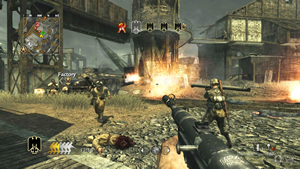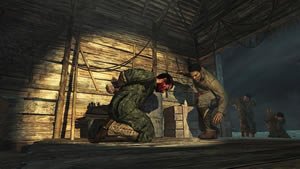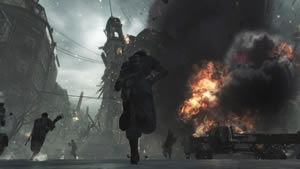Call of Duty: World at War is a first-person shooter video game developed by Treyarch and published by Activision for Microsoft Windows, Nintendo DS, PlayStation 2, PlayStation 3, Wii, and Xbox 360. It is the fifth installment in the Call of Duty series excluding expansion packs. The game’s setting returns to World War II,  after the previous title Call of Duty 4: Modern Warfare’s modern setting. It focuses on the Pacific Theater and Eastern Front of World War II in the Microsoft Windows, PS3, Wii and Xbox 360 version. The title, game details and estimated release date were announced on June 23, 2008 and the game was released worldwide between November 11, 2008 and November 14, 2008. A Windows Mobile version was also made available by Glu Mobile and different storyline versions for the PS2 and Nintendo DS were made, but remain in the World War II setting. The game uses an enhanced version of Call of Duty 4’s game engine with increased development in audio effects.
after the previous title Call of Duty 4: Modern Warfare’s modern setting. It focuses on the Pacific Theater and Eastern Front of World War II in the Microsoft Windows, PS3, Wii and Xbox 360 version. The title, game details and estimated release date were announced on June 23, 2008 and the game was released worldwide between November 11, 2008 and November 14, 2008. A Windows Mobile version was also made available by Glu Mobile and different storyline versions for the PS2 and Nintendo DS were made, but remain in the World War II setting. The game uses an enhanced version of Call of Duty 4’s game engine with increased development in audio effects.
The story for the PC, PS3, Wii and Xbox 360 focuses on the initial battles of World War II in the Pacific and Eastern Europe involving the United States, the Empire of Japan, the Soviet Union, and Nazi Germany. It is told from the perspectives of a Marine Raider and a Red Army soldier and is based on several historical battles, including the Makin Island raid, the Battle of Stalingrad, the Battle of Peleliu, the Battle of the Seelow Heights, the Battle of Okinawa, and the Battle of Berlin. The multiplayer portion of the game contains various game modes and a leveling system that allows the player to unlock additional weapons and rewards as they progress, which was originally implemented in Call of Duty 4. A new feature to the Call of Duty series is the cooperative mode, which can support up to four players online and two offline.
The game was the second best-selling game for November 2008 in the United States selling over 1.41 million units, and sold twice as many units in the UK in its first week compared to Call of Duty 4, becoming the third fastest-selling video game in the UK. It received a mixture of reviews. Some criticized the game for returning to World War II and not building upon Call of Duty 4, whereas others praised its portrayal of the gritty, dark side of the war. It was also criticized for jumping years ahead during the plot, but was also praised for the new co-operative mode introduced.
Gameplay
Call of Duty: World at War, the fifth installment of the Call of Duty series, features a more mature theme than previous installments in the series. The game is also open-ended, as there are multiple ways to complete objectives. The gameplay of World at War shares features with previous iterations of the franchise. Players fight alongside AI-controlled teammates, who help during the game’s missions by providing cover fire, shooting enemies, and clearing rooms for entry.
Gameplay on the Wii version of the game can be controlled with a gun-like expansion controller known as the Wii Zapper. The Zapper, or Wii Remote and Nunchuk, can be used to aim at targets to simulate marksmanship.
The game’s return to World War II-era warfare reintroduces weapons and technology that have been seen in other games in the Call of Duty franchise, including the Thompson submachine gun, the Mosin-Nagant rifle, and the Panzerschreck anti-tank rocket launcher. The player gains access to these over the course of the game, but may only carry up to two weapons in addition to hand grenades. Weapons from dead enemies can be picked up to replace weapons in a player’s arsenal. Players can also find weapons with additional attachments, including guns equipped with rifle grenades, telescopic sights, and bayonets.
A character can be positioned in one of three stances: standing, crouching, or prone; each affecting the character’s rate of movement, accuracy, and stealth. Using cover helps the player avoid enemy fire or recover health after taking significant damage, as there are no armor or health power-ups. After the character has taken damage, the edges of the screen glows red and the character’s heartbeat increases. If the character stays out of fire, the character can recover. When the character is within the blast radius of a live grenade, a marker indicates the direction of the grenade, helping the player in deciding whether to flee or throw it back at the enemy.
Multiplayer

Gameplay in online multiplayer’s War mode
World at War includes a similar multiplayer experience to Call of Duty 4. All versions of the game use a similar perk and ranking system and feature six different multiplayer modes, including team deathmatch and capture-the-flag.
The game also features a cooperative gameplay mode with up to two players via split screen on consoles, or four players online, for the first time in the franchise. The Wii version of the game does not include online co-op, but two players can play through a „squadmate co-op“ mode which allows both players to experience the game through the same screen and point of view.
Nazi Zombies
If the player waits for the credits after the campaign to end, Nazi Zombies starts. The game takes place on the map called Nacht der Untoten (German for „Night of the Undead“). It consists of 1-4 players fighting an unlimited number of waves of Nazi zombies. Players can work together to kill the zombies either offline with two players or online with 2-4 players. The players gain points by injuring or killing the zombies or repairing boarded-up windows, which are used to remove blockages such as couches or doors inside the bunker and to gain access to more useful weapons than the starting handgun. Guns are bought from outlines on the walls or the Mystery Box, which gives a weapon at random. Zombies continually break the boards on the windows or certain walls to gain entrance and to find and kill the players; when all players die the game is over. Downed players can survive if another player revives them or will respawn at the end of a round.
On March 19, 2009, Treyarch released map pack 1 which contained a new Nazi Zombies level. The new map is called Verrückt, which is German for „insane“.
A second map pack is scheduled for release in June 2009 with a new Nazi Zombies level entitled Shi No Numa (a.k.a. The Zombie Swamp), focusing on the Imperial Army, who have now become the new undead. New features include a misty swamp environment, perk machines, flaming undead hellhounds, the Wunderwaffe DG-2, and traps.
Synopsis
Characters
During the single-player campaign of the Microsoft Windows, Playstation 3, and Xbox 360 version, the player controls three different characters from a first-person perspective. Only two characters, Private Miller and Private Petrenko are available on the Wii. The player assumes the role of Private Miller of the United States Marine Corps‘ 1st Division and Private Dimitri Petrenko of the Soviet Red Army. Private Miller’s campaign starts as he is captured by the Japanese while scouting Makin Island and is rescued by Corporal Roebuck and his men from the Marine Raiders squad. He then continues through the Pacific campaign and ends at Shuri Castle on Okinawa Island.
Private Petrenko’s campaign starts when he is part of the 62nd Army in a water fountain where he pretends to be dead and watches German soldiers execute the rest of his unit in Stalingrad. Along with an injured teammate, Sergeant Reznov (voiced by Gary Oldman), he seeks revenge on the Germans and the „architect“ behind the attack, Nazi General Heinrich Amsel. Three years later, they meet again on the Eastern Front, alongside a third character, Pvt. Chernov. They advance towards Berlin with the 3rd Shock Army under the command of Commisar Markov, where they capture the Reichstag and Petrenko plants the Soviet flag after being shot by a hidden German that is then quickly killed by Reznov.
The third playable character in the campaign is Petty Officer Locke, a weapons operator on a PBY Catalina, who is only playable in the mission „Black Cats.“ This character is not available in the Wii version. Locke’s squadron makes a raid on a Japanese merchant fleet in the Pacific and later rescues the survivors of a destroyed U.S. fleet.Other non-playable characters in the game include Corporal/Sergeant Roebuck (voiced by Kiefer Sutherland), Sergeant Sullivan, and Private Polonsky (voiced by Aaron Stanford), who are in Private Miller’s U.S. squadron.
Plot

The opening scene of the campaign
The game starts in Makin Island at night on August 17, 1942. Private Miller watches the torture and execution of a fellow soldier by the Japanese. As they turn towards Miller, he is rescued by his crew and they assault the island, replicating the Makin Island raid. The following mission then starts two years later, where the Americans assault the Japanese-held island of Peleliu. Miller calls in rocket strikes to take out Japanese Ha-Gō tanks. At the end of the mission, Sergeant Sullivan is fatally impaled through the stomach by a Japanese soldier wielding a katana. The next mission starts in a swamp area of Peleliu, with Corporal Roebuck (now promoted to Sergeant, after the death of Sullivan), as they travel to the Japanese-held airfield. Miller acquires a flamethrower and bazooka during the mission.
The game then jumps to the Soviet campaign on September 17, 1942, during the Battle of Stalingrad. Dimitri Petrenko wakes up amongst dead bodies of his fellow soldiers, as the Germans shoot them. After they have gone, he meets Sergeant Reznov, a soldier from another unit. Reznov tells Dimitri that he wants to kill General Amsel, the man behind the Soviet casualties. After eliminating some German soldiers, Dimitri follows Reznov through buildings and streets, as they kill Germans on their way, using sniper rifles and machine guns, until Dimitri kills Amsel; at which point, they run and jump into the river. The following mission starts three years later at the Battle of the Seelow Heights, near Berlin, where Dimitri witnesses the torture of a fellow soldier by Germans and as the Germans approach Dimitri, he is saved by Soviet soldiers, including Sergeant Reznov. Together the Soviet troops advance through German lines, as Dimitri aids them with a Panzerschrek, as they reach a German camp.
The game returns back to Peleliu, where the Americans are pushing further inland through the island. Miller and his unit take out enemy mortar crews, so their tanks can go inland. They then disable Japanese guns, facing out to sea by taking out enemy infantry in caves.

A firefight in the streets of Berlin
The following mission campaign returns to the Battle of Seelow Heights. Dimitri is at the controls of a T-34 tank, as he helps the Soviet Army to reach the train station by destroying German tanks. He, along with Reznov and the Soviet troops, board a train to Berlin. Upon arrival they engage German soldiers in buildings and around the streets, as the Germans are retreating. The following day, Dimitri watches a fellow Soviet execute a surrendering German soldier. They then move through buildings and streets clearing out Germans, until they reach the entrance to the Berlin U-Bahn. Dimitri is ordered to kill surrendering Germans there, although they are executed by other Soviet soldiers, if he does not. They head into the U-Bahn and start fighting German resistance around the platforms, until a surge of water engulfs the tunnel.
The Battle of Okinawa is featured in the mission „Black Cats“, where the player takes control of Petty Officer Locke, in a PBY Catalina flying boat. He destroys Japanese PT Boats and merchant ships from the aircraft and then aids a U.S. fleet under attack. They rescue American sailors in the sea, while Locke shoots at Japanese PT boats and kamikaze planes, until more US aircraft arrive. The game shifts back to Miller, as he and his squad make a ground assault on Okinawa after the aircraft mission. They clear out Japanese from machine gun bunkers, allowing American tanks to progress. In the following mission they are ambushed while retrieving ammunition before starting their assault on Shuri Castle. Miller kills Japanese crew around mortars and the courtyards. Either Roebuck or Polonsky, depending on the player’s actions, is killed by surrendering Japanese soldiers. The surviving Americans fight off a final Japanese counterattack and take Shuri Castle.
The penultimate mission starts as Reznov drags Dimitri out of the U-Bahn to regroup with Soviet infantry. They clear out buildings along a street to proceed towards the plaza outside the Reichstag, where Dimitri destroys Flak 88s and they take out the remaining German infantry defending the entrance to the Reichstag. As they enter the Reichstag, they kill German soldiers in corridors, a lobby and the main room. After that, they clear out remaining German infantry on the roof of the building, Dimitri moves up to plant the Soviet flag. Before he can do so, a wounded German soldier rises up and shoots Dimitri with a pistol. Reznov comes to Dimitri’s aid and kills the German with his machete. He helps Dimitri up and cuts the swastika off the flagpole at the top of the Reichstag. Dimitri then plants the flag, signaling Soviet victory over Germany. A final cutscene details the end of the war in Europe, the dropping of the atomic bombs on Hiroshima and Nagasaki, and the peace accord signed as a result.
Development
World at War was announced on June 23, 2008 by Activision, Inc and Treyarch, which was to be released in late 2008 and set in World War II. The game had an approximately two-year long development cycle, double that of Treyarch’s previous title, Call of Duty 3.The game is powered by an enhanced version of the Call of Duty 4: Modern Warfare engine, with several improvements made to the physics model. Environments are more destructible and can be set on fire with the flamethrower, which features propagating fire. Not long after, Treyarch released the modding tools for Call of Duty: World at War. These tools were the same ones used to create all the other Call of Duty series games, but with slight changes version to version, which can be downloaded online. Kiefer Sutherland and Gary Oldman were cast as voice actors for the game. Sutherland voices the narrating character of the American campaign, Sgt. Roebuck, while Oldman voices that of the Soviet narrator, Sgt. Reznov.A full-sized replica PBY Catalina was constructed for motion capture use.
Audio
The music for Call of Duty: World at War was composed by Sean Murray. He was hired after Brian Tuey, Treyarch’s audio director, approached Murray. Murray stated that they had worked together earlier on True Crime: New York City, the sequel to the first True Crime: Streets of LA, and that „he [Tuey] knew I would bring a fresh approach to Call of Duty: World at War“. This also led to Adam Levenson, the audio director of Activision, being called in to help them. Murray also said that he wanted to make the music more fun and intense, but also „a specific musical path that follows the psyche of the gameplay“.
The new technology of occlusion, which changes the sound made by nearby object depending on objects blocking its path e.g. walls, has been added to World at War. The game has various levels of „muffled“ sound depending on the objects it travels though e.g. a more muffled sound through a thick wall compared to a slightly muffled sound through a thin short wall. For the first time in a Call of Duty game, the player is able to tell the difference between someone walking next to the player and someone walking above or below the player, as well as telling the difference between a shot fired in the distance and a shot fired close by, but behind a solid object.
The other technology of flux was also developed using field recording systems. The World at War crew traveled to a desert with mountains on both side of the range to test the frequencies of sounds made by World War II weapons. Microphones were placed 60 yards (55 m) behind and 60 yards in front of the gun to test the echoes. This was later replicated and developed in the studio for the game software. It means that players will be able to pinpoint a sniper rifle shot, as it reflects off them, as well as hearing the initial ‚pop‘ of a hand grenade blowing up and then the grenade’s loud „whoosh“ sound that begins where the grenade blew up, and ends behind the player. The flux system also combines with the occlusion system.
Sources: Wikipedia Modified by Fanterazzi